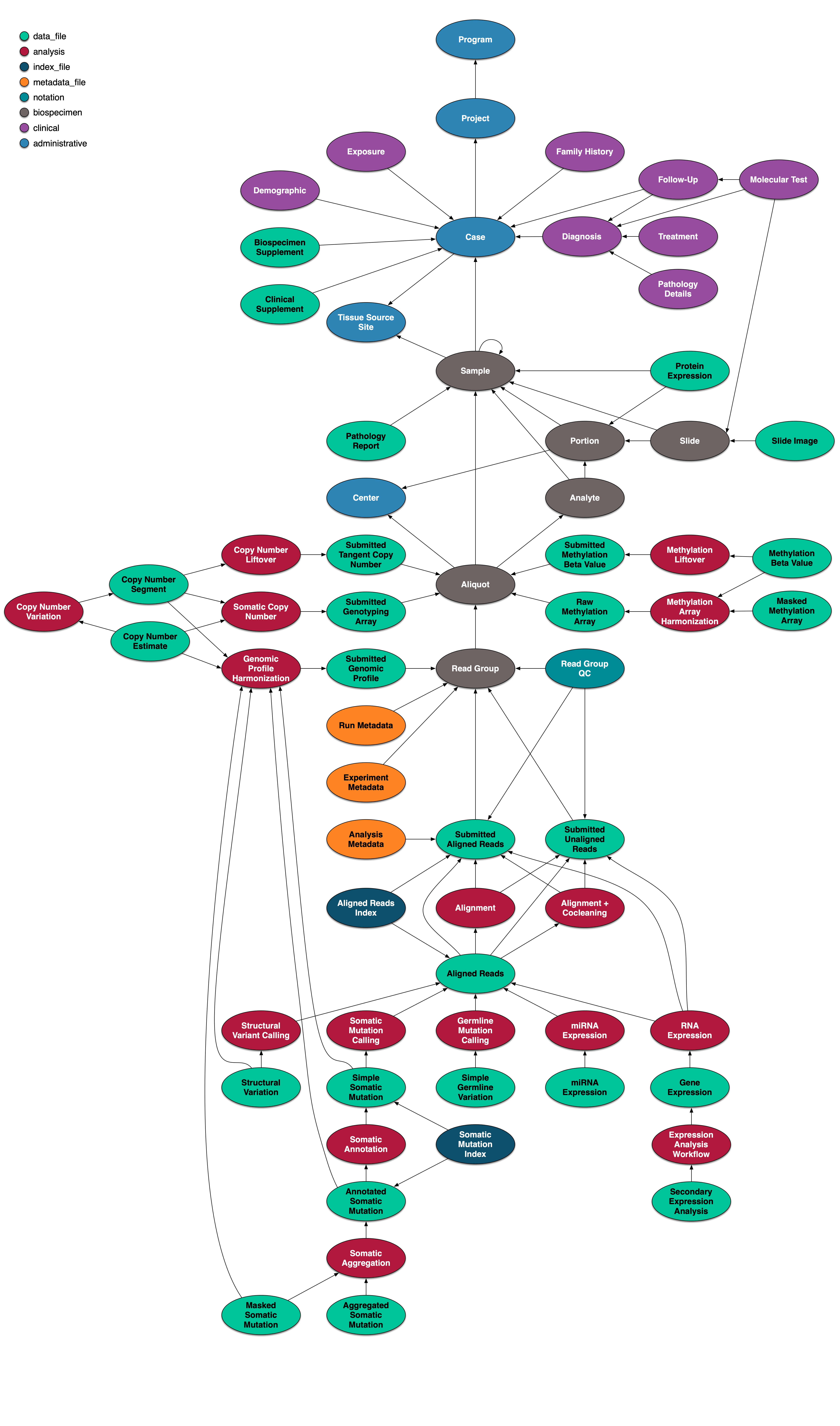Visualize DAG with Graphviz
25 Mar 2023At GDC, we have a graph saved in database. The structure of the graph is defined with GDCDictioanry. To write tests for our softwares, we need to create and load fake data in our test database. The fake data is usually in yaml format. With complicated test cases, we will need many nodes and edges in the test data. It will be hard to create or modify those fake data.

---
nodes:
- label: case
node_id: ee327e98-a722-4609-a9ff-e1da88169b3e
submitter_id: case_1
- label: sample
submitter_id: sample_1
tissue_type: Normal
sample_type: Blood Derived Normal
- label: portion
submitter_id: portion_1
- label: analyte
submitter_id: analyte_1
- label: aliquot
node_id: 1f8557c3-33a3-4fca-b7d1-2464f14c9514
submitter_id: aliquot_1
no_matched_normal_wxs: false
no_matched_normal_targeted_sequencing: false
selected_normal_wxs: true
analyte_type: DNA
selected_normal_targeted_sequencing: false
- label: read_group
node_id: dfbdabb5-5d9e-442a-a9ac-eea5132324ed
submitter_id: rg_1
single_cell_library: Chromium 3' Gene Expression v3 Library
target_capture_kit: SureSelect Human All Exon v5
- label: read_group
node_id: 2c560954-d0d0-4d35-9c44-24e483059697
submitter_id: rg_2
single_cell_library: Chromium 3' Gene Expression v3 Library
- label: submitted_unaligned_reads
node_id: 57261c6c-918d-4b71-b96c-80db0024fa7a
submitter_id: sur_1
experimental_strategy: m6A MeRIP-Seq
edges:
- src: sample_1
dst: case_1
label: cases
- src: portion_1
dst: sample_1
label: samples
- src: analyte_1
dst: portion_1
label: portions
- src: aliquot_1
dst: analyte_1
label: analytes
- src: rg_1
dst: aliquot_1
label: aliquots
- src: rg_2
dst: aliquot_1
label: aliquots
- src: sur_1
dst: rg_1
label: read_groupsTo help us with large test data, we should visualize the test data. It is much easier to understand the relationships with charts than reading a yaml file. Graphviz is an opensource graph visualization software. Dot language is used by graphviz to create the graph. As we are mostly using python for our develop, we use the python version of graphviz to generate our chart.
To visualize our test data, I wrote a the following script using graphviz to create a chart. And my colleague Rowland add color to the graph so different node types will have different colors.
import json
import os
import uuid
from functools import lru_cache
from typing import Dict, List
import requests
import yaml
from graphviz import Digraph
def draw(nodes: List[Dict[str, str]], edges: List[Dict[str, str]], reverse=False):
dot = Digraph('g', filename='btree.gv',
node_attr={'shape': 'record'})
node_id_to_submitter_id = {}
for node in nodes:
submitter_id = node.get("submitter_id")
node_id = node.get("node_id")
suffix = f":{node['gencode_version']}" if node.get("gencode_version") else ''
if submitter_id and node_id:
node_id_to_submitter_id[node_id] = submitter_id + suffix
elif submitter_id:
node_id_to_submitter_id[submitter_id] = submitter_id + suffix
else:
node_id_to_submitter_id[node_id] = node_id + suffix
print(node_id_to_submitter_id)
for node in nodes:
n_id = node_id_to_submitter_id.get(node.get("node_id") or node.get("submitter_id"))
# print(n_id, node.get("submitter_id"), node.get("node_id"))
dot.node(n_id, fillcolor=get_color(node["label"]), style="filled")
for edge in edges:
src = node_id_to_submitter_id.get(edge["src"]) or edge["src"]
dst = node_id_to_submitter_id.get(edge["dst"]) or edge["dst"]
# print(src, dst, edge['src'], edge['dst'])
if reverse:
dot.edge(dst, src)
else:
dot.edge(src, dst)
return dot
def draw_yaml(yaml_raw):
try:
yaml_dict = yaml.load(yaml_raw)
except yaml.scanner.ScannerError:
yaml_dict = json.loads(yaml_raw)
return draw(yaml_dict['nodes'], yaml_dict['edges'])
def draw_url(url):
response = requests.get(url)
print(response.status_code)
return draw_yaml(response.content)
@lru_cache(maxsize=256)
def get_color(label: str) -> str:
label = str(uuid.uuid5(UUID_NAMESPACE, label))
label_color = hex(int("".join(map(str, map(ord, label)))) & 0x00FFFFFF)
return "#{:f<6}".format(label_color[2:])
UUID_NAMESPACE_SEED = os.getenv("UUID_NAMESPACE_SEED", "f0d2633b-cd8b-45ca-ae86-1d5c759ba0d1")
UUID_NAMESPACE = uuid.UUID("urn:uuid:{}".format(UUID_NAMESPACE_SEED), version=4)It simply use dot.node(node_id) to add a node to the chart and dot.edge(src_node_id, dest_node_id) to add an edge to the chart.
Now the data above will be converted to the following chart:

This is much easier for developers to analyze the data and understanding the relationships between the nodes and edges in the data.
If the above example is not strong enough. Here is another picture. With so many nodes, it will be almost impracticle to understand and remember all the relationships by only reading the yaml file.

This tool has made our developer work much more joyful.